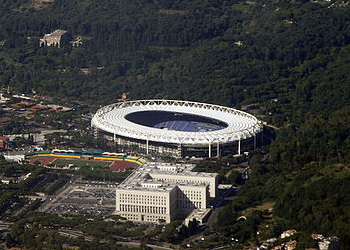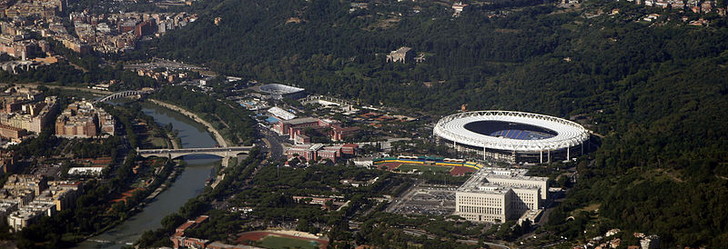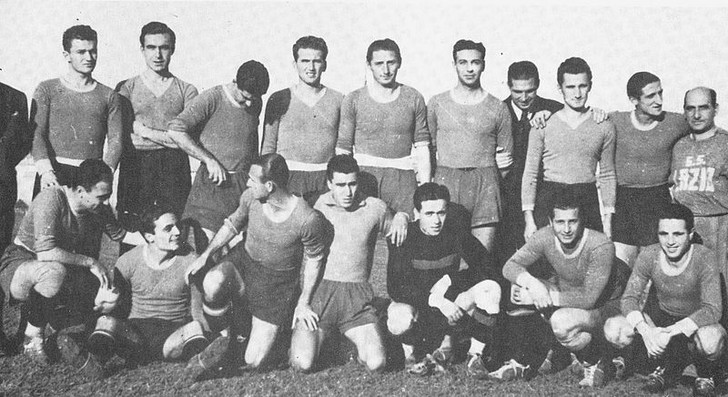
Italy’s capital city is known for so many reasons that it will perhaps be tricky for us to list them all. The capital of the Lazio region, the most populous in the country and the fourth-most populous in all of the European Union, the Metropolitan City of Rome boasts a population of more than four million residents.
The city is the only one in the world that technically contains a country within its borders, with Vatican City being an independent country separate, to some extent, from the rules and laws of the rest of Italy. The history of the city goes back twenty-eight centuries, to the point that it is known by historians as the birthplace of Western civilisation. It’s entirely fair to say, therefore, that there’s more going on in Rome than simply football.
Yet football very much is one of the passions of the citizens of Rome, which is quite remarkable when you consider how much culture they are surrounded by at every single turn. The centre of the Italian Renaissance and then the birthplace of both the Baroque and Neoclassical styles, it seems somehow remarkable that the home of the Colosseum, the Pantheon and St. Peter’s Basilica is visited almost as regularly by people hoping to watch live sport as appreciate wonderful buildings.
It’s also worth noting that, whilst it is best known for the big two clubs of AS Roma and SS Lazio, it’s also home to eight other, less well-known clubs. These include the likes of Atletico Roma F.C., Lodigiani Calcio and S.S. Racing Club Roma, though it will be just the big two and their associated football ground that we’ll be telling you about here.
{module Maps – Cities – Rome}
Football Stadiums in Rome
| Stadium | Capacity | Team | League |
|---|---|---|---|
| Stadio Olimpico | 72,698 | AS Roma / SS Lazio | Serie A |
AS Roma – Stadio Olimpico (3.54 Miles to The Colosseum)

Commonly known simply as ‘Roma’, Associazione Sportiva Roma was formed in 1927 by a merger of three other clubs that were based in Rome. Italo Foschi decided to persuade Roman FC, SS Alba-Audace and Fortitudo-Pro Roma SGS to come together in order to create a football club in the nation’s capital that would be able to rival clubs from the more dominant Northern part of Italy. It was also hoped that another club in Rome, named Lazio, would also join the merger to create a truly formidable side. The only reason that they didn’t was because of the intervention of General Vaccaro, who was an executive of the Italian Football Federation and member of the club who felt that they would be best served going their own way. Instead, the other clubs ploughed on without Lazio to create Roma, a Sports Association for the nation’s most important city.
The new club played its first season in the Motovelodromo Appio Stadium, but by November of 1929 they’d built their own all-wooden ground in the working-class district of Tesaccio that was called Campo Testaccio. They immediately felt at home in their new stadium, finishing as runners-up to Juventus in Serie A. They struggled to keep this new team together, however, and their league form suffered as a consequence. It was only under the management of Luigi Barbesino, who re-built the playing squad with talented goalscorers, that they were able to return to pressuring the clubs at the top of the Italian league. Pressure them they did, though, missing out on the 1935-1936 title by just a single point. Six years later, after plenty of steady progress, they picked up their first Scudetto; thanks in part to the eighteen-goal haul of local boy Amedeo Amadei.
From that moment on, the club had countless ups and downs. They didn’t win Serie A again until the 1982-1983 season, a break of more than forty years. They didn’t leave it quite as long before their next league title, but even that didn’t occur until 2000-2001. They’ve picked up nine Coppa Italias and two Supercoppa Italianas, though the only European trophy that they’ve managed to win over the years was the Inter-Cities Fairs Cup in 1961. That lack of success has been due to several different things, with the overwhelming success of clubs like Juventus being a large part of things. Yet Roma have also had to endure a turbulent history, with takeovers in the boardroom matched by a lack of success on their pitch. They were also unfortunate to lose the 1984 European Cup final to Liverpool on a penalty shoot-out; an event which may have changed the course of the club if they’d been victorious.
Roma’s nicknames are interesting. One of them is I Giallorossi, which translates as ‘The Yellow and Reds’ because of the club’s crest. Another is La Lupa, which translates to ‘The She-Wolf’ and might explain why the club’s badge appears to be a wolf being suckled by two small children. Moving away from that rather weird fact, we’ll return to their stadiums. They remained at Campo Testaccio until 1940, at which point they moved to the Stadio Nazionale del PNF. They remained there until 1953, when they moved into the Stadio Olimpico, which they share with their Rome rivals Lazio. They’ve played there ever since, with the only exception being the 1989-1990 season when they had to play their games in the Stadio Flamino as the Stadio Olimpico was being reconstructed ahead of the World Cup.
It is fascinating to look at Italian football through the prism of the English game. You could never imagine the likes of Arsenal and Tottenham, Liverpool and Everton or Manchester United and Manchester City sharing a stadium, yet it’s a relatively common occurrence in Italy. AC Milan and Internazionale share the Stadio Giuseppe Meazza in Milan, for example, and then you have Roma and Lazio sharing the Stadio Olimipco here. Perhaps Roma have never felt entirely comfortable sharing a stadium with such fierce rivals, which might explain why the club president announced in 2012 that they would be building a new ground in Tor di Valle, a district of Rome. Unfortunately for the football club, however, that idea has been beset by problems. Roma have had to extend their stay at their current home until 2020, with no idea at present when, if ever, they’re likely to move. Which begs the question, is their rivalry with Lazio really that bad?
Lazio – Stadio Olimpico (3.54 Miles to The Colosseum)

Supporters of Le Aquile, or The Eagles, would no doubt tell you that they are Rome’s original football club. Società Sportiva Lazio was formed in 1900 as Società Podistica Lazio and played its football in the amateur leagues for the first decade of its existence. The society officially joined the Italian Football Federation in 1912, the point at which it began to host championships in central and southern Italy. We mentioned the club’s refusal to merge with the other football teams to create a super club for Rome in 1927 and it probably tells you a lot about those involved with Lazio that they did so because a merger was the desire of Italy’s fascist regime. They took part in what was the inaugural Serie A in 1929, lending further credence to the idea that Lazio was Rome’s first true football club.
It might have been the first, but it’s never been the city’s most successful club form a domestic point of view. They didn’t win Serie A for the first time until the 1973-1974 season and have only won one more since – that coming in 1999-2000. They’ve picked up six Coppa Italias and four Supercoppa Italianas, trailing Roma’s domestic trophy count by two. Where they unquestionably do get one over on their rivals, though, is when it comes to success in Europe. Lazio won the UEFA Cup Winners’ Cup in 1999 and the UEFA Super Cup in the same season. Perhaps that is what makes the rivalry between the two sides so heated, with matches played in the Derby della Capitale amongst the most explosive in world football – sometimes quite literally. For example, in the derby during the 1979-1980 season, a Lazio fan named Vincenzo Paparelli was hit in the eye by a rocket and died.
Given this incredibly intense rivalry, it’s fascinating that the two clubs are able to share a stadium. Yet it was also somewhat inevitable, given the fact that the Stadio Olimpico is easily the largest stadium in the capital of Italy, boasting a capacity of more than 70,000. Once it opened in 1937 it was only going to be a matter of time before the city’s two football clubs ended up moving into it. Initially called the Stadio dei Cipressi, it was renamed as the Stadio dei Centomila when it was fully completed in 1951 and was able to welcome around 100,000 people through its doors. Before either Roma or Lazio were able to play their games in it, it was the home of the Italian national football team and was officially inaugurated on the seventeenth of May in 1953 when Italy played Hungary. It earned the right to use its current name when it hosted the 1960 Summer Olympics, being used as a venue for the opening and closing ceremonies as well as the athletics.
Lazio as a football club has its own ties to the Olympics. When the club was formed it wasn’t exclusively for football, instead being a mixed sports club. As a result, the club chose to take on white and sky blue as its kit colours, making an homage to Greece as the home of the Olympics – the true multi-sports tradition in Europe. They initially had these colours split into quarters and accompanied by black shorts and socks, but eventually they changed things to play with a sky blue shirt and white shorts and socks. It is these colours that have led to the club being given the nickname ‘the biancocelesti’. That link to Greece can also be found in the club’s symbol of an Eagle, chosen by a founding player named Luigi Bigiarelli who wanted to have a link to the god of the sky and thunder in Greek mythology, Zeus.
Back to that rivalry with Roma, then, and in some ways it has been stoked by the cultural differences between the two sets of supporters. Lazio fans tend to come from the more affluent parts of the Northern areas of Rome, such as Parioli, Prati, Flaminio, Cassia and Monte Mario. Roma’s supporters, on the other hand, tend to be from the inner-city areas of Rome, especially the district of Testaccio where their wooden stadium was built all those years ago. Roma supporters certainly have a reputation of being more violent than their Lazio counterparts, having previously been involved in violent clashes with supporters of English side like Liverpool, Manchester United and Arsenal. Indeed, fans of all of those clubs have been stabbed when the teams have met in Europe. Lazio’s ‘ultras’, on the other hand, were known as the Irriducibili Lazio and tend to create magnificent visual displays when the clubs meet. They have a friendly relationship with supporters of Internazionale from Milan. Unlike Roma, Lazio haven’t announced any plans or desires to leave the Stadio Olimipico to date.
